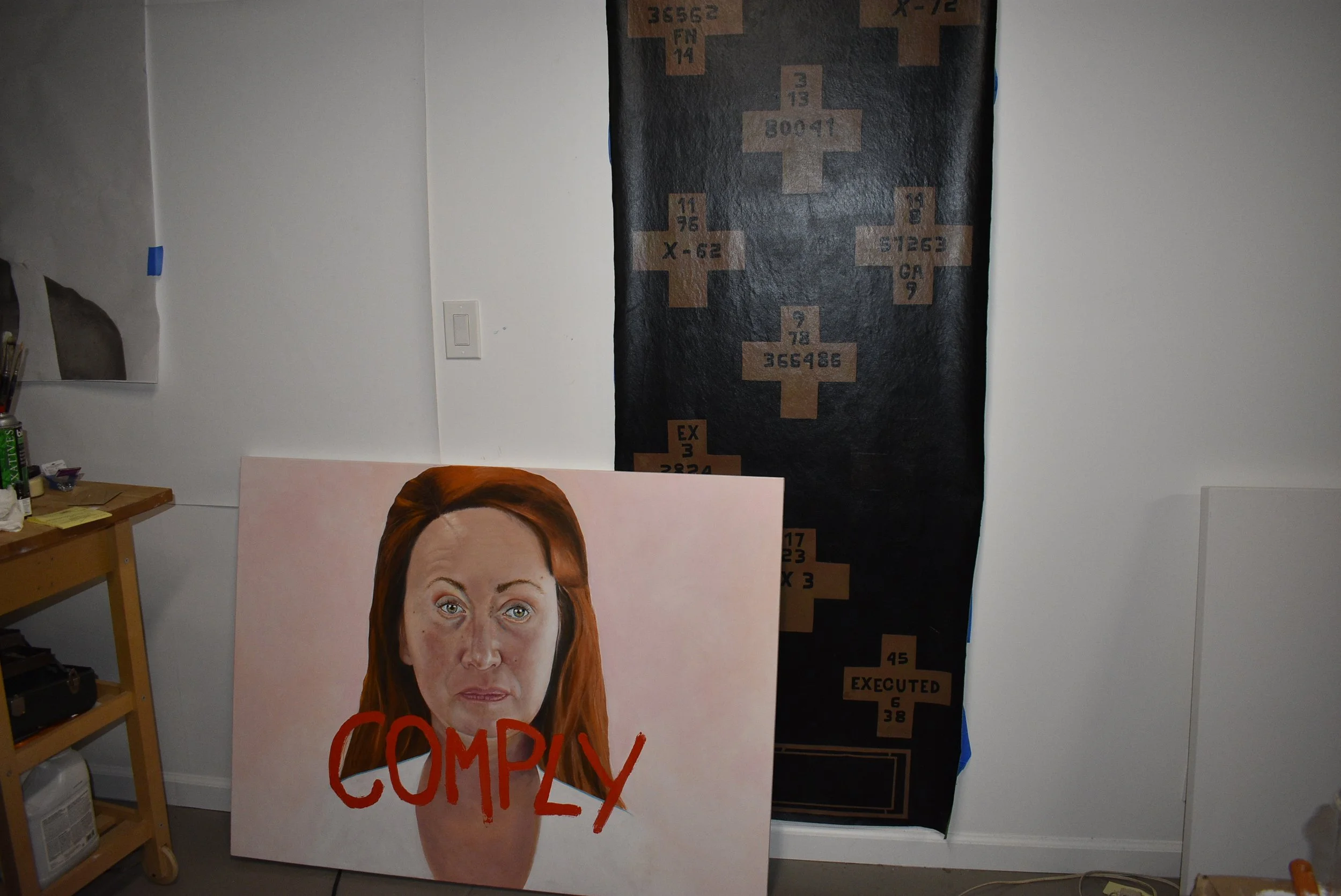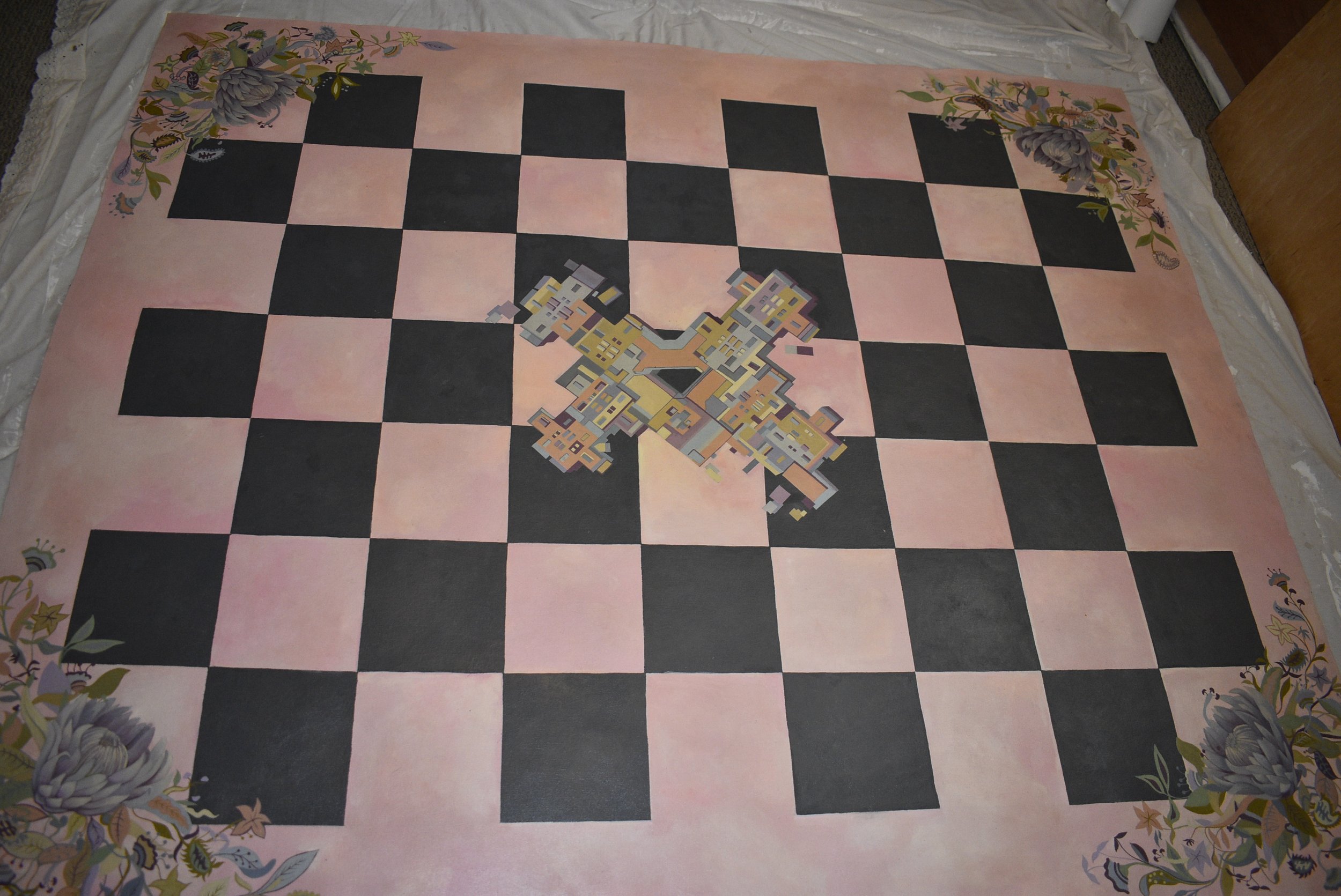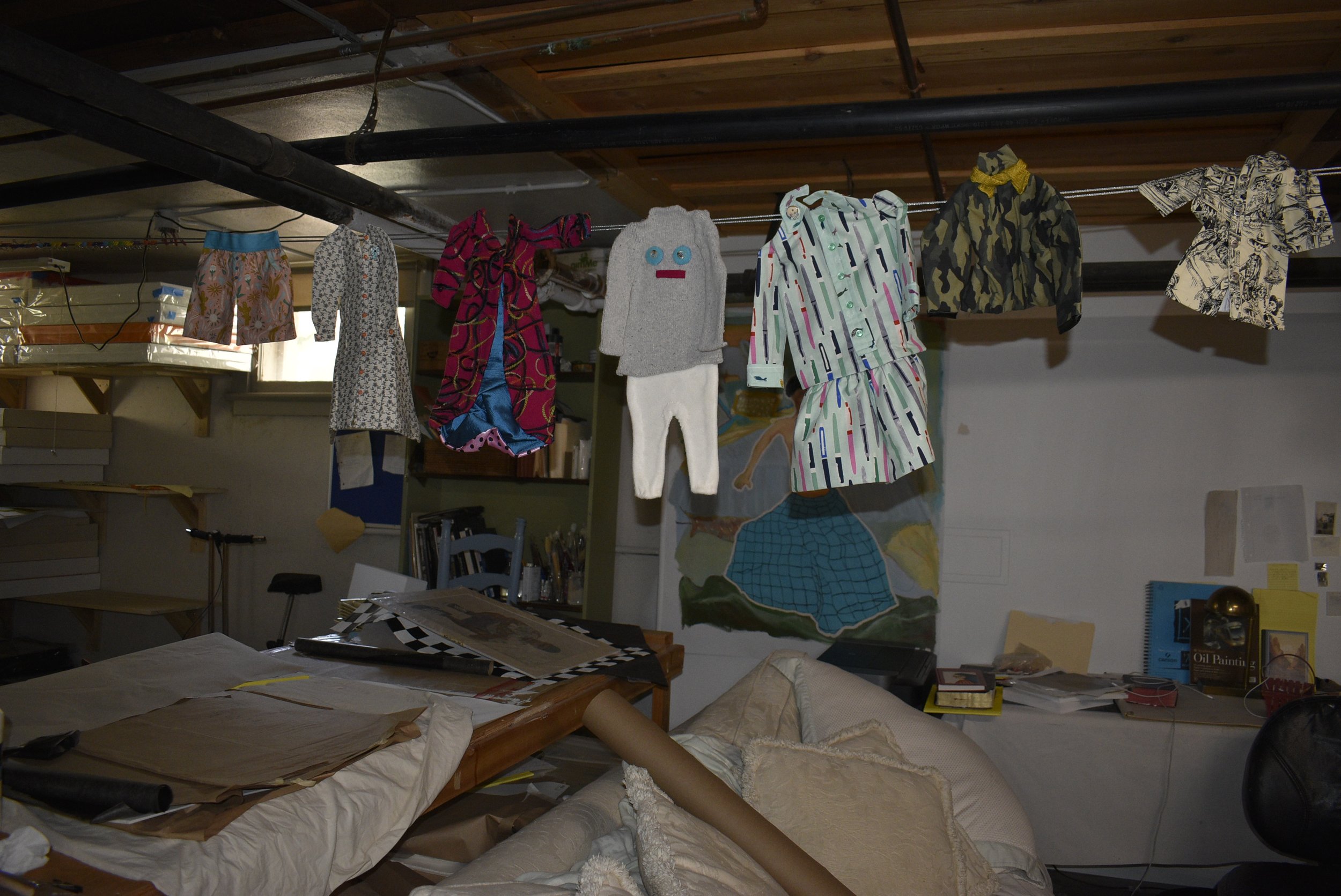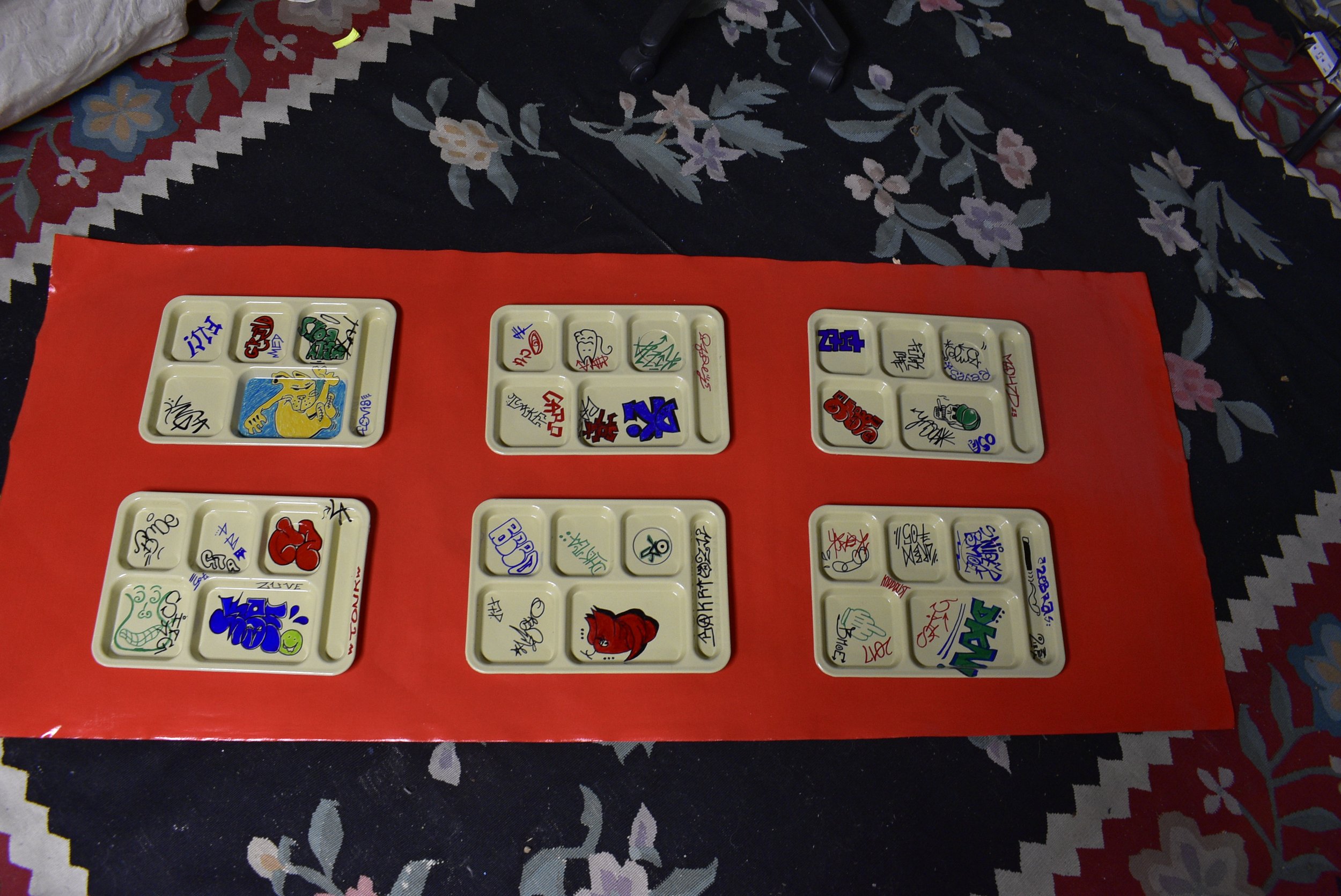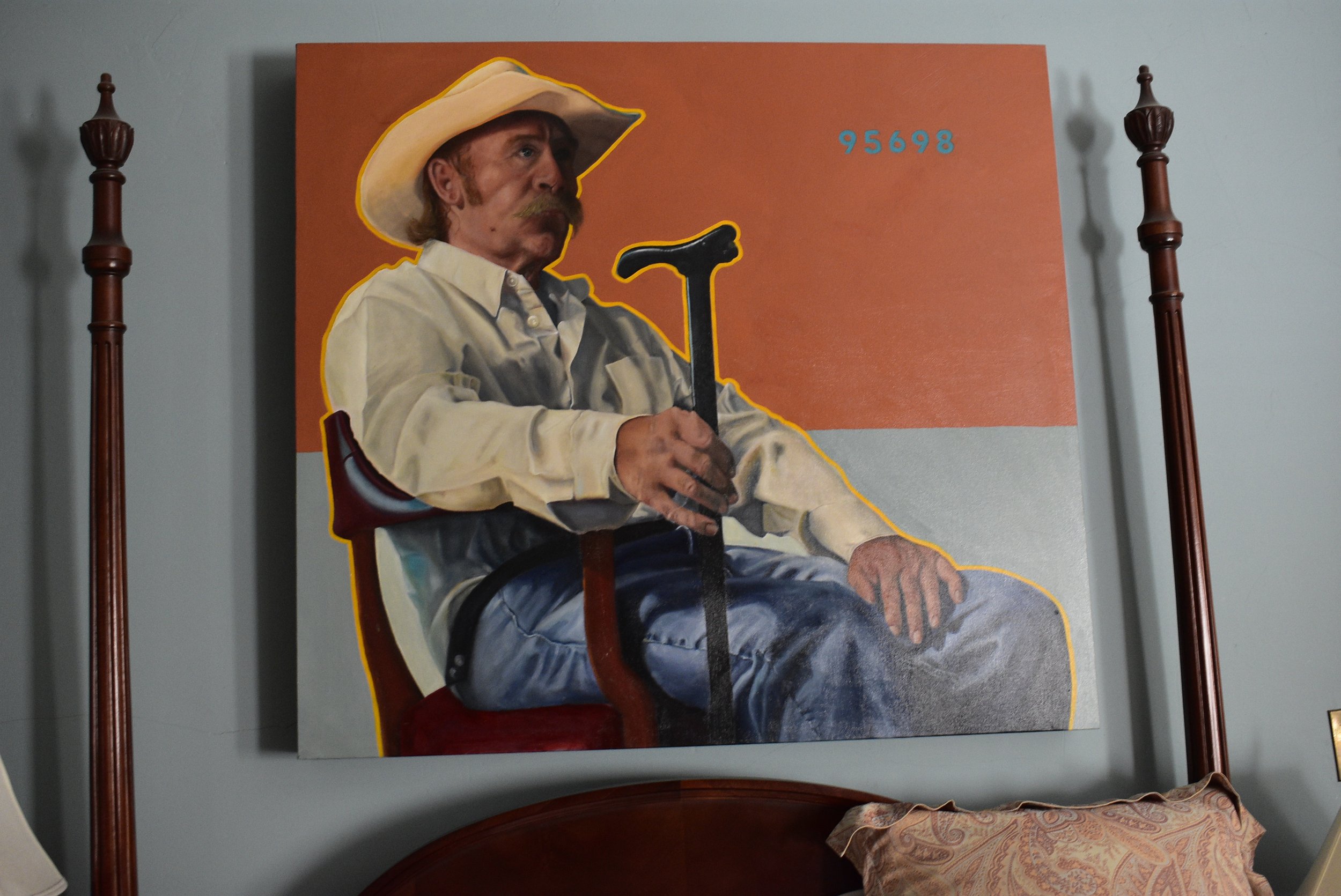A painting on the right by Glynn Cartledge part of a series which according to the Nevada Arts Council “cross-examines the criminal justice system… She paints portraits of formerly incarcerated citizens in both formal settings and as whimsical paper dolls. She paints early immigrant floor cloths as contemporary prison rugs, which link poverty and otherness and suggest that incarceration follows us home. Collaged jail cells, recorded oral histories, and archival documents from both her files and from formerly incarcerated people provide context.”
It was a hot, sweaty day when I met Glynn Cartledge on the porch of their Reno home. The Truckee river rushed past us just to the north. The riverwalk was a lively scene, buzzing with weekend festivities. Glynn’s home, however, provided a peaceful oasis. “I’m very lucky to live here,” they told me. And with the important work they’re doing, Reno is lucky to have Cartledge here as well.
Glynn is an artist who was recently awarded a fellowship with the Nevada Arts Council. Their work is full of color and life, but the subject matter that inspires Cartledge’s art isn’t quite fun and games. “My art is a conversation with the criminal justice system,” Glynn says. And after working as a defense attorney for over twenty years, Cartledge has much to say.
In their career, Glynn says they encountered a great deal of injustice, including racism and classism.
According to The Sentencing Project, “Black Americans are incarcerated in state prisons at nearly five times the rate of white Americans– and one in 81 Black adults in the US is serving time in state prison.” A 2019 publication details the startling facts around pretrial detention– or, waiting for your trial in a jail cell. According to this research, “nine out of ten defendants in jail awaiting trial are there because they either cannot or choose not to meet the release conditions set in their cases. Most likely they cannot afford to pay the bail that has been set.” Being detained in jail before going to trial, many times results in harsher sentencing. This means that folks who cannot pay bail are operating at a disadvantage from the get go.
To learn more about Glynn and some of their work, visit: https://www.glynnbcartledge.com/contact
Glynn witnessed, first hand, these institutional disparities. Unfortunately they say they also saw a lack of effort from their own colleagues.
Cartledge speaks of one man who died on death row. “Not by execution,” they clarify. “He just died of old age.” According to Glynn, they selected the jury on Monday, and by Wednesday they had finished the trial. The judge released the verdict before the end of the week. “How can that have been justice?” Glynn wonders, seemingly still searching for the answer. “You may say, well he killed people. I don’t think he killed people, but anyway, everybody deserves representation. It’s in the constitution. We don’t want poor innocent people going to prison. Or, poor people who did something bad, but not as bad as the government says. The government has all the power.”
Luckily, Glynn is still encouraging conversations about criminal injustice. Now, however, they take a different approach. “I have always painted or drawn,” Cartledge tells me. “I had my first art lesson at five years old, that my dad took me to…I went to the University of Georgia where I was majoring in art. Then I dropped out, because I didn’t like one of my professors. I ended up going to law school, kind of out of need. I really loved (law school), but I continued to paint all these years, and study, and take classes from mentors. Then I entered art school again, and dropped out again– so I’m a two time art school dropout. I’m kind of a rebel that way. I do what I want to do.”
“I became really serious about it in about 2010. And that’s when I began to paint my friends and people that I knew.” Glynn started out painting formal portraits of people they had represented, or other formerly incarcerated people who they connected with. They started work on a series called P2P, or “prisoners to paper dolls.” These portraits display subjects painted with oils on canvas. Their arms are outstretched, palms up. And alongside these portraits are “paper doll clothes,” sewn by Cartledge. “ I’m trying to communicate their worth,” Glynn says, “but also how the public, including myself– how we view them.”
Glynn started making collaged jail cells on canvas as well, illustrating realities of life in a cage. They’ve also recorded oral and written histories from those with histories of incarceration. “I have them write a five page, or more, history… about what they want to talk about. They have to be felons– a felon means that you went to prison– and you aren’t an ex-felon. That never happens. You’re always a felon.”
What Glynn calls “deadpan portraits” are paintings of people from their chest up, (“more like mug shots,” they say), with a “call to duty” painted across the width of the canvas. “For example, I just painted Jenni…with the word ‘comply’ painted across her in red letters– to state that she’ll have to comply with all the rules and regulations and fines and fees when she gets out. So she’s still, kind of– punished.” And “carceral cloths,” are inspired by the history of early immigrants, who painted ship sails to use as floor cloths. These painted sails mimicked the expensive rugs owned by wealthier Americans back then. Glynn repurposed this idea to symbolize the link between poverty and imprisonment. “Mine have images on them, and the images and the colors, everything, has to do with prison. For example, I (included) handcuffs, sexual positions.. and all the rugs are made on unstretched cotton canvas, just like the used sails that they had back in the day. I’m going to put one on the floor at my next exhibition. It’s 8x6 feet, the standard size of a prison cell.”
Cartledge’s artwork calls us to conversation and action, and it’s a platform for them to share the truth they’ve discovered. “...People who are incarcerated, either in jail or in prison, are human beings. They deserve dignity, they deserve decent treatment, and whether you think they need to be imprisoned or not, I think that they deserve to be treated as any citizen would like to be treated. 97% of those in jail are coming out. So if we mistreat these people in prison, feed them bad food– which we do– if it’s brutal and gang infested– which it is…these people are going to be your neighbors. So if you can’t (take action) for them, do it for yourselves, and for your community.”
Glynn and I chatted about how chaotic the world feels now, and how difficult it can be to focus on any singular crisis, or issue. But change doesn’t always occur on some grand scale. It can look like a conversation with neighbors and friends, or a painting which can open minds and hearts to an incarcerated member of our community.

